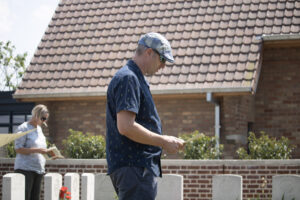News
September 13th 2023
103rd Regiment Royal Artillery travel to Ypres on battlefield study
In June, 28 members of 103rd Regiment Royal Artillery travelled to Ypres, Belgium, for Exercise Northern Asterix.
In June, 28 members of 103rd Regiment Royal Artillery travelled to Ypres, Belgium, for Exercise Northern Asterix.
Over the course of the two-day trip, Reservists from the North-West and Midlands – including Sgt Connolly, of C Troop, Bulwell – travelled around the Ypres Salient studying the events during and leading up to the Third Battle of Ypres, a campaign of the First World War.
The battlefield study aimed to cover five key topics, namely to understand:
- the role of Reservists
- the significance of the moral component
- the geographic framework
- the combined arms manoeuvre
- and the importance of remembrance.
Day one: A double Victoria Cross recipient, the soldiers’ rest, and Menin Gate
Day one got off to a busy start. The first stop was the grave of Captain Noel Chavasse, a double Victoria Cross winner of the Royal Army Medical Corps. Cpt Chavasse was a pre-war Territorial (Reserve) Officer whose gallantry and service highlighted the contribution Reservists played in the First World War.
We then moved to Talbot House, in Poperinge. Opened by Chaplain Philip Clayton, the house became a refuge for soldiers wanting a brief respite from the realities and horrors of war. It was here that we discussed the moral component of fighting.
Following this, we laid a wreath at the grave of Major Eric Dougall VC, which allowed members of the group to pay their respects to one of our own.
We then received an introduction to combined arms warfare, which helped us to analyse the use of mines during the Battle of Messines with a visit to Hill 60. This stand provided greater context of the role of artillery in the battlespace.
We finished the day by attending the last post-ceremony at the Menin Gate. This ceremony has been performed at the gate every evening (except between 1940 and 1944) at the gate since 1928.

Day two: Hellfire Corner and Tyne Cot Cemetery
Day two promised to be busy with plenty to learn. We kicked off with a talk on the geographic framework, using Hellfire Corner as a case study.
Hellfire Corner was the name given to a key junction used as a main supply route by the British Army for its proximity to essential rail infrastructure and was heavily bombarded by the Germans throughout the war.
Hellfire Corner was so heavily shelled that if spread across the whole war, there was enough ordnance used for a shell to land every 10 seconds. Using this example, we looked at how the geographical framework decides how we fight, for example, winning the deep battle to ensure success in the close.
From there, we moved onto the Hooge Crater Museum where we received a specialist workshop about the forms and development of artillery from one of the museum’s historians. The group was informed about the different shells, fuses, and methods used by the artillery in the conflict. This provided insight for the less experienced gunners in the group and allowed them to further understand modern systems.
Next up was the Passchendaele Museum. It was here that the group gained a deeper insight into the lives of the soldiers who fought around the Ypres Salient. At the Passchendaele Museum, we were also afforded the opportunity to explore a recreated trench network, which was able to articulate the proximity and nuance of life and warfare in the trenches.
Finally, and most poignantly, we paid a visit to Tyne Cot Cemetery where nearly 12,000 British and Commonwealth troops are buried – and 40,000 more are remembered as missing in action. It was here that we contemplated the importance of remembrance, and what it means to us today. We looked back on those who were lost, not just in the First World War, but in all conflicts, and took a moment to remember. This, we felt, was a strong and heartfelt way to end the exercise.

Ex Northern Asterix
Ex Northern Asterix was a highly successful two days of learning. The soldiers explored a range of topics, from the individual stories of those who came before us to the lessons we related to modern doctrine. The soldiers and officers of 103 Regiment learned good lessons to take back with them. It is these lessons that will enable our soldiers to develop their own knowledge and encourage them to learn more. We look forward to next year!
With thanks to 103 Regiment Royal Artillery for sharing their battlefield study report.

